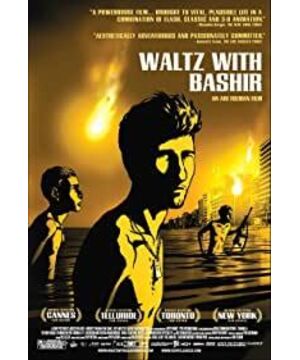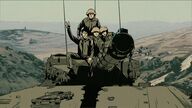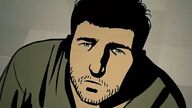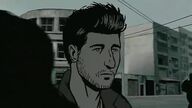The Israeli movie "Waltz With Bashir" (Waltz With Bashir) is difficult to categorize. Is it a documentary or a cartoon? The Oscar jury was the most interesting and simply nominated it as the "Best Foreign Language Film". It is unexpected, but it is not ridiculous, because "Waltz" is a Hebrew film, but in this way, a masterpiece that should be recorded in the history of documentary can easily be fooled by Oscar. "Waltz" should be regarded as the first animated documentary in history. In fact, the use of two-dimensional and three-dimensional animations in documentaries has become more and more popular. Last year, in Chicago 10, another documentary that was ignored by Oscars for no reason, the director used a large number of three-dimensional animations to reproduce scenes of US court trials. "Not enough shots" is a challenge that documentary creators always face, and how to present historical events for which no image data can be found is particularly sad. The previous approach was to find photos to deal with it. American documentary director Ken Burns pushed this style to its peak. Although the narrative purpose can be achieved, the audience looks somewhat boring. In film and television production, animation is much more vivid than photos. Once used reasonably, the narrative effect can immediately jump to a new level. For those generations who grew up in Second Life, just relying on a few old photos dangling in front of the camera to tell stories is a matter of pre-liberation. In addition, in addition to the difficulty of reproducing history, documentary narratives often encounter other passages that cannot be actually photographed, such as dreams, memories, and hallucinations. In 2008 documentaries, American Teen and other works have begun to use three-dimensional animation to describe dreams and fantasy. If these innovative attempts make people happy, then the birth of "Waltz" can really make people ecstatic. This is a documentary that uses almost all animations. It is very experimental, and the roughness and rigidity that may be encountered in bold attempts hardly appear in "Waltz", and the creative maturity is amazing. Documentary director, Israeli Ari Folman appears directly in "Waltz", the sound is his original sound, but the picture is his cartoon image. Folman visited old comrades-in-arms, and everyone recalled their own experiences in the 1982 Israel-Lebanon conflict. Like Folman, most of the other interviewees also used a combination of original sound and cartoon characters, with only two exceptions. In the animation design, the director did not use the best technology at present, and the character description cannot be said to be particularly detailed. This is Folman's creative choice, he did not deliberately pursue photographic realism. If you are more careful, the audience can still see the difference between these roles in the movie and when they were young. They were thinner, fairer skin, and more hair. I particularly like the director’s treatment of light and shadow: when a character in the movie retreats to the shade of a tree, the original bright image gradually transforms into a silhouette; driving at night on the thoroughfare, the shadow of the street lamp on the driver’s face Has been in turmoil and change. An excellent movie, no matter how large it is, still needs details to be filled in to be attractive. Everyone participated in the same war, but their memories of the war were different. Folman has forgotten most of the details. His companion Boaz often dreamed of 26 dogs flying along the avenue in Tel Aviv, the capital of Israel, and then gathered under the window of his house and barked. Boaz found Folman and told him about his nightmare. Folman thinks that a psychologist can help. He is just a documentary filmmaker. "Doesn't movies have psychological effects? (Can't films be therapeutic? )”, Boaz reminded. Folman only started to create "Waltz". He began to use animation to reflect on the war. As an Israeli soldier, Folman and his comrades were victors in the war, but also victims of the trauma of the war. Among them Many people in 1982 have experienced the most tragic scene in 1982. Lebanese right-wing Christian militia massacred Palestinian civilians on the grounds of the assassination of President-elect Bashir. The Israel Defense Forces, which was responsible for maintaining order, did not intervene in time. Faced with conscientious condemnation. Some people adopt an evasive attitude. The photographers who participated in the interview forced themselves to believe that the tragedy only happened on film, which is actually different from real life. When the self-deception failed, his psychology was immediately on the verge of collapse. Folman has suppressed his memory for many years. With the deepening of communication with his comrades, he also began to be entangled in nightmares. In the dream, he and his comrades stood up naked from the sea outside Beirut. From the perspective of visual design, this paragraph The shot is perfect. The realistic outline of Beirut city is arranged in the background. In the foreground are the thin silhouettes of Folman and his comrades. There is also a design with strong visual impact in the movie: a huge female lying on her back on the water, Folman’s comrades attached On her body, she looks like a baby. At first glance, you can explain that people yearn for peace and tranquility under the pressure of war, but if the surrounding sea water is blood red, your understanding may be different. Future creations will continue to emerge. The possibility of an animated documentary may not be great, but "Waltz" is enough to herald a new artistic pursuit. Animation can express the most serious and heaviest themes. It will definitely become an important link in the creation process of news and documentary films. Who does not need animation The kind of freedom to rebuild time and space provided?
View more about Waltz with Bashir reviews







